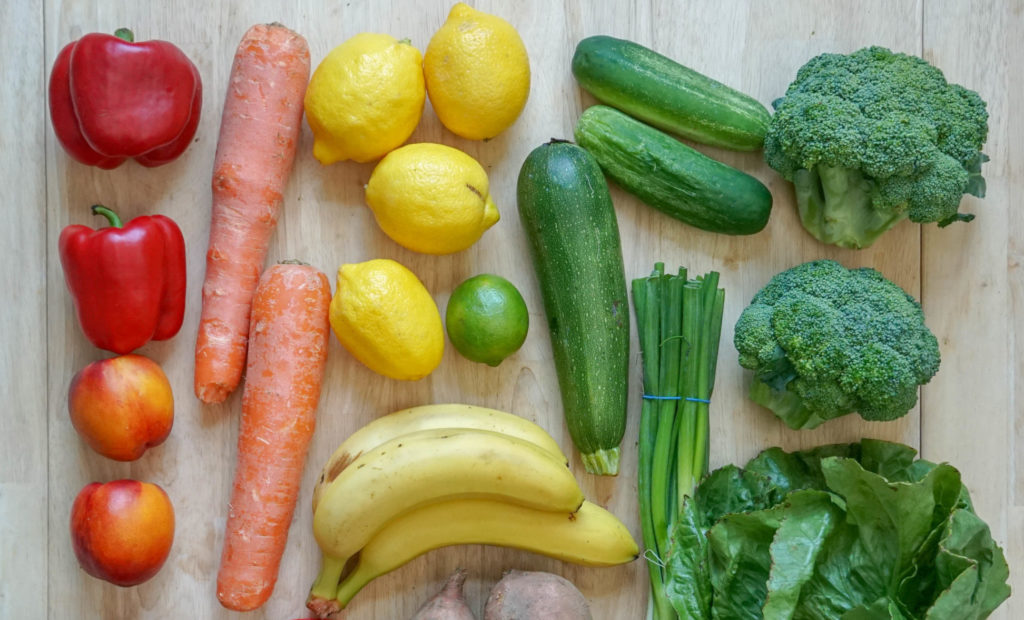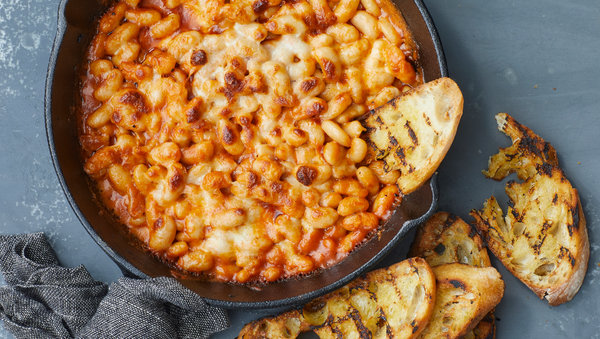Grocery shopping on a budget is not impossible. It only seems like some kind of feat of logistics to set a grocery budget and then actually stick to it. It’s definitely a challenge, especially because food costs seem to only go in one direction. And that’s the direction that takes more money out of your proverbial wallet.
But there are some simple tricks and tips you can follow in order to keep yourself within your budget. It’s not actually as tough as you might think. And it makes perfect sense, too, to shop this way if you’re living the meal planning life; you can buy what you’re prepping and that’s it. (It’s so easy to splurge when grocery shopping because food is, after all, an essential!). By implementing these tips, you can cut your grocery budget in half with a few changes. Grocery shopping on a budget doesn’t have to be a headache!
Quick pro tips for grocery shopping on a budget
- Track your spending with an app like Mint or You Need A Budget to make sure you stay within your budget. And then pay attention to what you’re buying and make any necessary adjustments. (Are you buying only what you need?)
- Buy bulk when you can, and if you have the space to store everything in your home! Here are our Costco recommendations.
- Always make your grocery list before you go shopping. Better yet, plug your grocery list into an online food shopping site like Instacart to better calculate how much your food will actually cost.
- Don’t go shopping WHEN YOU ARE HUNGRY. You’ll be far too tempted to buy more than you need and more than you can afford. And that not only potentially wastes money, but food, too.
Explore more plant-based protein options to save money on food

Plant-based proteins like beans, tofu, tempeh, and lentils are excellent swaps for more expensive meat products on your grocery list. Beef is $2-4 per serving, pork is a close second behind that and chicken is a little more affordable. But if you’re eating a lot of meat, the grocery bill will reflect that.
On the other hand, canned beans are $0.18-$0.50 per serving, and lentils are incredibly affordable, too. Switching from eating meat to going a little more plant-based a few nights per week saved me some serious cash. Beans are a versatile, protein-rich addition to tacos, soups, curries, and pasta. It also added some diversity to my diet and got me to try some new things. Not a bad thing!
With the Workweek Lunch meal prep program you get access to 400+ meal prep recipes with vegan/vegetarian and omnivore versions of each plan.
Don’t be afraid to buy frozen vegetables
One of my biggest struggles with eating vegetables isn’t the taste – it’s the waste! I used to buy fresh produce every week and whatever I didn’t eat would spoil. Not fun. Frozen vegetables are a cheaper, shelf-stable way to incorporate vegetables into meals. Frozen vegetables have a bad rap, but they are equally as nutritious as their fresh counterparts. In fact, lots of brands mention on their packaging now how the produce is flash-frozen at the peak of freshness.
Vegetables I constantly used to let spoil, like spinach and peppers, are some of my go-to frozen buys now. They’re ready when you are, and can be used in a multitude of ways, such as soups, stir-fries, tacos, frittatas, pasta, risotto, and so on. You’ll always find a bag of fresh corn and fresh peas in my freezer, along with veggies I’ve frozen from the summer (peppers, roasted tomatoes, etc.). Because if you have a veggie in the freezer, you’re on your way to making dinner.
Once you understand proper freezing methods, you can use your freezer to reduce waste, diversify your meals (aka beat boredom), and save time and money.
RELATED: 5 Freezer-Friendly Meals
Look for fresh vegetables that have a longer shelf life
Potatoes, onions, and hard squashes can last 1-2 months if stored in a cool, dark environment. Sturdy veggies like carrots, beets, cabbage, and celery can stay fresh for one to three weeks in the refrigerator. Their long shelf life makes these veggies a good option for bulk-buying. In my grocery store, a 3-pound bag of yellow onions is just a couple of bucks, but if you buy by the pound, it’s more expensive. Take a look.
Greens are a different story. You’ll likely buy what you need, when you need it, and maybe that’s weekly. But those can spoil too. (Check out these tips for using up your greens before they go bad.) The one exception? Frozen chopped spinach is great for cooking. Not so great, of course, for making salads.
Spend a little now to save later
This might sound a little crazy, because we are talking about exercising restraint. But sometimes you get into the grocery store and see they’re having a great sale on ground beef or chicken breasts. Here’s where it’s smart to spend a little now to save time and money later.
Allow for a little wiggle room in your budget because you may need it. In these situations when I stumble upon sales like this, I know I would probably spend more if I had a bigger freezer, so I am grateful for my standard-issue kitchen freezer. It helps me keep the budget in check. Here’s what I do. I’ll buy two pounds of ground meat, and plan to use one during the week and freeze the other for later. And then when you’re rummaging around looking to clear out the freezer and be super economical, future you will be so happy you bought that extra package of chicken or beef or whatever it is.
RELATED: 25 Delicious Meal Prep Recipes That Use Ground Beef
Skip the brand names
Brand names are enticing, but their products are usually similar to, if not the same as, the generic brand’s products. Store-brand beans at my grocery store are $0.99 per can, while the brand name costs upwards of $2. The little things add up when you’re trying to decrease your grocery budget!
The only exception here? Sometimes brand names go on such a deep sale that it makes more sense to buy them vs. the generic. You can always check the unit price on the label on the shelf to determine which is the more cost-effective move.
Make your own snacks
Although pre-packaged snacks are convenient, making my own snacks helps me stay on budget. Simple swaps like buying popcorn kernels rather than pre-popped corn, baking muffins, or making my own snack boxes are some of the ways that I cut down on my snack spending. When you’re grocery shopping on a budget, it’s always a smart move to make what you can from scratch. And if you’re already doing prep work on the weekend, you can easily introduce snacks into the process, too. It doesn’t have to just be meals. (Snacks are mini-meals, anyway!)
Stop buying food you’re not going to eat
I know this sounds obvious, but we all do it. I probably have a bag of lettuce in my fridge right now whose days are numbered. One of the best ways to save money on groceries is just being honest with yourself. Yes, carts full of kale and rice cakes look pretty in pictures, but will you really eat that stuff once you get it home? It’s better to spend your hard-earned money on food you actually want to eat, not what you think you should eat.
In a similar thought, I would take it a step further and say don’t buy food you’re not going to eat THIS WEEK. Buy what you need, when you need it. That also seriously helps to curtail unnecessary food spending.
Here are some of my favorite budget-friendly recipes that use some of the swaps I mentioned above.
Tofu That Tastes Good: Stir Fry by The Minimalist Baker

Tofu can be daunting for those who have never cooked it at home before. This recipe shows you how to make easy, crispy tofu that could make any omnivore happy. The veggies in this dish are also great candidates for a fresh-to-frozen swap.
Homemade Snack Packs
I love pre-packaged fruit, nuts, and cheese boxes, but they can be pretty pricey. To save some cash, I started making them at home with honey-roasted peanuts, dried cranberries, and cheddar cheese. They’re delicious and less than a dollar a serving!
Banana Oatmeal Blender Muffins by Well Plated

Baking can be messy and time-consuming, but this muffin recipe only uses one piece of equipment – the blender! You could add chocolate chips, nuts, or dried fruit to these muffins if you wanted to get creative.
Cheesy White Bean Tomato Bake by Ali Slagle

This dish is nicknamed “pizza beans” in my house, and it’s a delicious way to get some plant-based protein in your diet. To make it even better, this dish is only under $2 per serving.
We can help you make grocery shopping on a budget even easier
We hope you found these budget-friendly tips helpful! If you’re looking for more budgeting tips, click here to get my list of 12 ways to cut down your grocery bill on your next shopping trip!
What are your favorite tips and tricks for saving money while grocery shopping? How do you make a budget and stick to it?
Leave a Reply